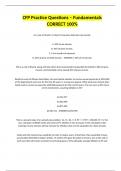CFP Practice Questions – Fundamentals
CORRECT 100%
As a rule of thumb, it is best if consumer debt does not exceed:
A. 20% of net income.
B. 20% of gross income.
C. 3 to 6 months of expenses.
D. 36% of gross monthly income. - ANSWER A. 20% of net income
This is a rule of thumb, along with the others that recommend housing debt be limited to 28% of gross
income, and total debt not to exceed 36% of gross income.
David has won the Illinois state lottery. He must decide whether to receive annual payments of $250,000
at the beginning of each year for the next 20 years, or a lump sum payout. What lump sum amount does
David need to receive to equal the $250,000 payments for the next 20 years, if he can earn an 8% return
on his investments, assuming inflation is 3%?
$2,454,537
$2,650,900
$2,875,900
$3,307,511 - ANSWER $2,650,900
This is a present value of an annuity due problem. So, N = 20, I = 8, PV = ?, PMT = 250,000, FV = 0. Put
your calculator in BEGIN mode and solve for PV. Inflation is not necessary in this calculation, lotto
winnings income streams will not increase for inflation, they are the equivalent to a fixed annuity.
Cathy and John Gonnerman would like to retire in twelve years. At that time, they would like to have
accumulated $350,000 in today's dollars. To achieve this goal, they plan to invest a sum at the end of
each year that will remain constant in purchasing power. They anticipate average inflation at 6% and
, have an after tax investment earning capacity of 9%. What payment is required at the end of the first
year for them to reach their goal?
$34,806.25
$26,394.63
$27,978.31
$50,104.88
$45,563.97 - ANSWER $26,394.63
The correct answer is B. The payments increasing each year will keep pace with inflation at the end of 12
years.
N=12 i=[(1.09/1.06)-1] × 100=2.83 PMT=24,900 × 1.06=26,394 FV=350,000
Which of the following is/are true regarding registering as an investment adviser?
I. Exceptions are not governed by the Investment Advisers Act of 1940 at all.
II. Exemptions are governed by Section 206 of the Investment Advisers Act of 1940.
III. Exceptions include advisers whose only clients are insurance companies.
IV. Exemptions include banks and bank holding companies.
I only.
I and II only.
II and III only.
II and IV only. - ANSWER I & II
Exceptions are not governed by the Act. Exemptions need not register, but are governed by the "anti-
fraud" provision (Section 206) of the Act.
, Hannah currently has $715,000 saved. She will retire in 10 years and wants to take $100,000 income for
25 years at the beginning of each year. She also wishes to have $1,000,000 35 years from now to leave to
her heirs. What is the internal rate of return needed to accomplish this?
6.99%
7.09%
7.13%
7.26% - ANSWER 7.09%
Gwyneth currently earns a salary of $30,000 per year with ABC Company. She has the opportunity to
attend a full-time training program for two years, if she is willing to quit her job and forgo her current
salary. If she chooses to attend the training program, she will earn a salary of $40,000 per year after
graduation, for the next 18 years. The cost of the training program is $9,000 annually. Gwyneth is
currently earning a 6% rate of return on her investments, and inflation is 3%. Gwyneth will be unable to
earn any income while she completes the training. What is the net present value to Gwyneth if she
chooses to attend the training program?
A. $26,354.
B. $57,739.
C. $116,890.
D. $461,645. - ANSWER B.
This problem requires utilizing an uneven cash flow function on a financial calculator.
Time Period 0 (-9,000 and - 30,000) outflow - Gwyneth is not working and will forsake the $30,000 she
could have earned as well as pay training costs of $9,000. The total cash outflow is $39,000.
Time Period 1 (-9,000 and - 30,000) outflow - Gwyneth is not working and will forsake the $30,000 she
could have earned as well as pay training costs of $9,000. The total cash outflow is $39,000.
Time Period 2-19 - $10,000 inflow (18 years - Gwyneth will give up a salary of $30,000, but instead will
earn $40,000 for 18 years. Therefore, her net increase in income is $10,000 per year if she attends the
training program)
I/YR - (1+.06)/(1.03) - 1 = 2.9126 [utilizes an inflation adjusted rate of return]
NPV - $57,739.




